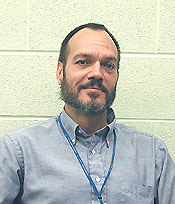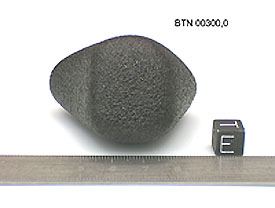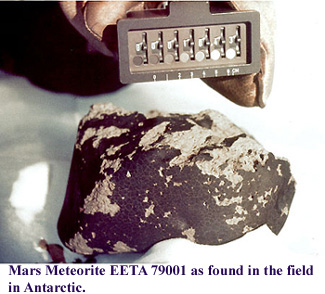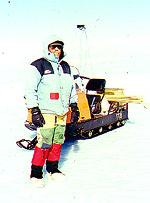 Program News
Program NewsDave Mittlefehldt
New Meteorites
This newsletter contains classifications for 287 meteorites. Most (262) are for meteorites in the 1999 ANSMET collection that were taken from the Queen Alexandra Range area, but we also have classifications for the first samples from the 2000 field season, which were taken from Meteorite Hills (24), and one for a sample from Bates Nunataks that appears incredibly fresh (see figure below).  In fact, it looks so fresh that we decided to count it in the JSC low-level gamma-ray counting facility on the off chance that short-lived cosmogenic radionuclides were still present. We didn't detect any.
In fact, it looks so fresh that we decided to count it in the JSC low-level gamma-ray counting facility on the off chance that short-lived cosmogenic radionuclides were still present. We didn't detect any.
For meteorites in the 2000 collection, we are announcing several CM2 chondrites, a CR2 chondrite, several diogenites (some unusual), a eucrite, two howardites, and a plethora of ordinary chondrites. As you might guess, most of the QUE meteorites classified here are LL5 chondrites (181!). However, we have also turned up other ordinary chondrites; a small diogenite; a small eucrite; a CR2 chondrite; and an ungrouped chondrite, possibly paired with QUE 94411. In addition, we have three meteorites that are probably paired with QUE 99059 and friends. Avid readers of this newsletter will remember that QUE 99059 brought a classification problem to my attention because it was tentatively paired with three other meteorites that were listed under two different classifications. Based on one opinion contained in a lengthy e-mail, we now classify all seven of these meteorites as "Enstatite Meteorite, Ungrouped." These are clearly unusual meteorites that deserve detailed study. Descriptions are given here for 19 meteorites of special petrologic type.
The Newsletter was in press when we received the descriptions of several irons from T. McCoy; we added them. Although 26 individuals are listed, these likely represent three different meteorites. Two individuals have been added to the Derrick Peak pairing group, and 24 individuals were recovered from the Meteorite Hills area. One is a meteorite of unusual type represented by single small individual. The remaining 23 individuals are tentatively classified as IIIAB and appear to represent a single fall, which may have been recent. The irons were found in what is plausibly a part of a strewn field. More details on this are on our web site at: MeteoriteHills.htm
JSC Lab Renovations
Facility upgrades continue. We appear to be in the final stages of upgrading the air handler system in the Meteorite Processing Lab (MPL) - work that was scheduled for completion in July. Once the upgrade work is completed, the lab will be completely cleaned before we start new processing work. We sincerely hope to be up and running by mid-September.
Plans for the 2001-2002 Field Season
Ralph Harvey
Bear with me on this one. Most of you are aware of the famous Chinese blessing that doubles as a curse: "May you live in interesting times." What you may not know, however, is that this statement is not really Chinese; it's reportedly the first of three progressively more awful curses occurring in the fictional China of Ernest Bramah's The Wallet of Kai Lung (1900). The lesser-known (but equally intriguing) second and third curses from that work are "May you come to the attention of those in high places" and "May the Gods grant your prayers."
 Ironically, these blessings together do a good job of portraying the planning progress for the 2001-2002 field season.
Ironically, these blessings together do a good job of portraying the planning progress for the 2001-2002 field season.
For about a year now, NASA has been working with ANSMET and National Science Foundation to see if we can support a second field party that would increase the overall recovery rate of Antarctic meteorites and thus increase the recovery rate for Martian meteorites. The rationale for this, of course, is last year's reorganization of NASA's Mars Exploration program, which postponed plans for the return of Mars samples into the next decade. For ANSMET, which has seen diminishing budgets over the previous decade, this is the proverbial "answer to our prayers." But, despite the fact that it's an offer we can't really refuse, making this second field team a reality has been, as the faux Chinese curse suggests, "interesting."
As of this writing, we are planning two field parties: a group of eight that will continue the work at Meteorite Hills we began last year and a group of four that will perform high-level reconnaissance at a number of ice fields in the region immediately south of the Queen Alexandra Mountains. This group will have a high level of aircraft support, which will minimize travel time and cargo needs and allow the group to make significant recoveries from a number of poorly known sites. The hope is that this combined strategy of systematic recovery from known sites and exploratory high-grading of new sites will result in the discovery of significant new meteorite stranding surfaces and the recovery a few new Martians in the process.
Right now, part of the money needed to create this second field party is in hand: funds to hire a second mountain guide and a post-doctoral researcher who will serve as a scientific "first officer" and to cover medical, dental and travel costs for the additional volunteers. Major logistical support needs were estimated in a proposal to NASA, but as of this writing, these are still in the approval process. In the event that logistical support simply can't be provided this year, we'll send the party of eight to Meteorite Hills and try to keep our momentum up for a two-party field season next year.
 One last thing - this year marks mountaineer John "Johnny Alpine" Schutt's 21st field season with ANSMET, and ANSMET's 25th season overall. Please join me in honoring John Schutt's contribution; we hope to have a special slide show dedicated to John and a celebratory dinner when we host the Antarctic Meteorite slideshow this year. Thanks to all of you for your continued support.
One last thing - this year marks mountaineer John "Johnny Alpine" Schutt's 21st field season with ANSMET, and ANSMET's 25th season overall. Please join me in honoring John Schutt's contribution; we hope to have a special slide show dedicated to John and a celebratory dinner when we host the Antarctic Meteorite slideshow this year. Thanks to all of you for your continued support.